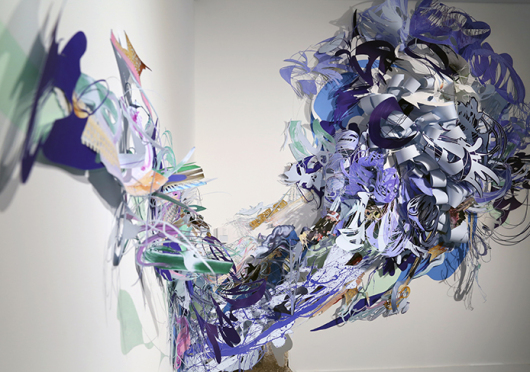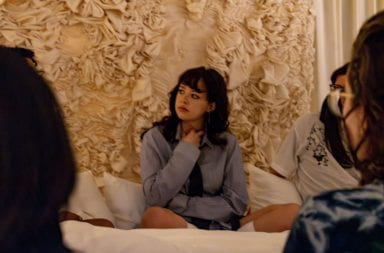
‘Skyview 837’ by Samantha Parker Salazar Credit: Courtesy of Kelly McNicholas
Samantha Parker Salazar, an artist and printmaking lecturer at Ohio State, said she recalls the summers spent as child at her grandparents’ greenhouse drawing cartoons. The “flower house,” as they called it, was not only filled with various plants, but also tables, chairs and the sounds of her grandmother’s Hungarian opera music. Here, in a space underneath a cherry tree that made sounds of rainfall as it poured cherries onto the glass, was the beginning for Salazar and the artist she is today.
Now, as a recipient of John F. Fergus Family Fellowship in 2014, Salazar has been given the opportunity to be a professor and present her exhibition, “Malleable Matrices” Jan. 10 through Jan. 29 at OSU’s Urban Arts Space.
“Coming to OSU has been invaluable,” Salazar said. “It has opened up so many doors, like giving me the opportunity to teach while also focusing on my studio practice.”
Salazar, who works with elements from traditional printmaking in her art, said she tries to instill that mindset in her students.
“I encourage them to think out of the box and work beyond tradition,” Salazar said.
“Waking Red,” one of Salazar’s installations at the Urban Arts Space, is meant to convey a vivid memory from her childhood: her cousin dissecting a pregnant frog.
She described the event as one that only little boys do. Salazar remembered being given the duty of holding the flashlight over the pregnant frog while her cousin dissected it.
“He was pulling out all of these white, round eggs,” she said. “It was something I will never forget.”
Salazar also wrote a poem — which won an award from the American Academy of Poets — about the event.
Salazar says that even though “Waking Red” has a gruesome backstory, its beauty draws the viewer in.
“It’s kind of like watching a car wreck, you just can’t look away,” she said. “Maybe at first you don’t know what it is, but when you look closer you find out that it’s something much deeper than you originally expected.”
Salazar said the vinyl frogs positioned on the bottom level were manipulated with Photoshop to skew and distort them.
“This is the clue for viewers to realize what the piece is really all about,” she said.
She said that without this clue, viewers wouldn’t understand the piece because at the top, the frogs are too distorted.
“I always give hints and clues in my pieces as to what it’s dealing with,” she said.
“Skyview 837,” another Salazar installation at the Urban Arts Space, is meant to show how people see the world through a digital window.
“There’s this whole other world that we are living in physically, but then there’s this other world that has become its own: the Internet,” Salazar said.
Salazar said she has experienced more places than she really has visited because of things on the Internet.
“I was thinking about our views of the sky above and how it was mediated through this window,” she said. “I wanted to reference what was outside by bringing in the colors and the shapes with paper.”
She said “Skyview 837” wasn’t as personal as “Waking Red,” instead just an impactful thought that she had.
Kelly McNicholas, spokeswoman for the Urban Arts Space, said the “Malleable Matrices” exhibit shows the unlimited options with the medium of printmaking.
“When people think of printmaking, they think of what one is able to fit on a screen,” McNicholas said. “Salazar has blown the walls off of that medium and made it an installation.”
Merijn van ver Heijden, deputy director of exhibitions and curatorial practice at the Urban Arts Space, said Salazar’s devoted work ethic and dedication to her work doesn’t end once a piece has left her studio.
“She is very hands-on,” Heijden said. “She was down here (at the Urban Arts Space) during the actual installation of her pieces and essentially directed it. She helped install the entire exhibition.”
Along with working as a full-time artist, Salazar has another job: being a mother to her 2-year-old daughter, Felicity, and wife to her husband, Rolando.
Salazar said that without the support of her husband, none of this would be possible.
Salazar said she views herself as more relatable to students because she is just starting to makes waves in the art world.
“I hope that students will look at my work and gather that it is entirely possible, even with a family,” she said.
When comparing herself to other artists, Salazar said it’s her spin on using color, form and shape that makes her different.
“Of course I have to accept the fact that everything has been made before,” Salazar said. “I just find a way to add something new to the conversation.”


